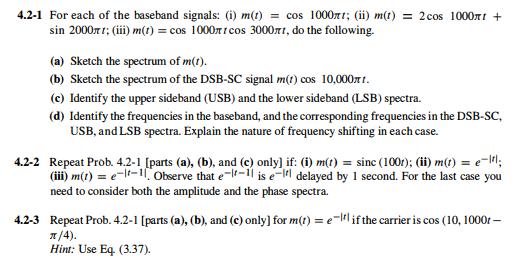4.2-1 For each of the baseband signals: (i) m(t) = cos 1000t; (i) m(t) = 2cos 1000n + sin 2000rr: (ii) m(t) = cos

4.2-1 For each of the baseband signals: (i) m(t) = cos 1000t; (i) m(t) = 2cos 1000n + sin 2000rr: (ii) m(t) = cos 1000rt cos 3000r1, do the following. (a) Sketch the spectrum of m(t). (b) Sketch the spectrum of the DSB-SC signal m(t) cos 10,000rt. (c) Identify the upper sideband (USB) and the lower sideband (LSB) spectra. (d) Identify the frequencies in the baseband, and the corresponding frequencies in the DSB-sC, USB, and LSB spectra. Explain the nature of frequency shifting in each case. 4.2-2 Repeat Prob. 4.2-1 [parts (a), (b), and (c) only) if: (i) m(t) = sinc (1001); (ii) m(t) = e-"; (iii) m(t) = e-t-1 Observe that e--1l is e-l delayed by 1 second. For the last case you need to consider both the amplitude and the phase spectra. 4.2-3 Repeat Prob. 4.2-1 [parts (a), (b), and (c) only) for m(t) = e-lifthe carrier is cos (10, 1000r A/4). Hint: Use Eq (3.37).
Step by Step Solution
3.38 Rating (148 Votes )
There are 3 Steps involved in it
Step: 1

See step-by-step solutions with expert insights and AI powered tools for academic success
Step: 2

Step: 3

Ace Your Homework with AI
Get the answers you need in no time with our AI-driven, step-by-step assistance
Get Started


